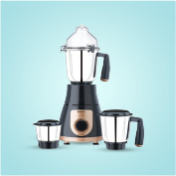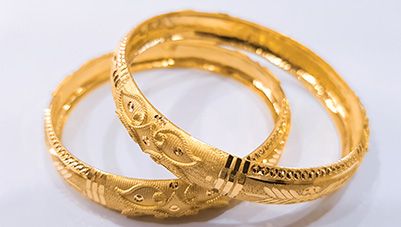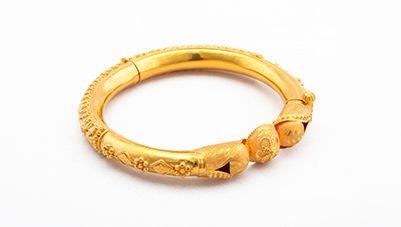Rs. 5,000 - Rs. 2 crore
To find the nearest gold loan branch,
Enter phone and OTP | Check amount you can get | Apply for quick funds
Understanding the weight of gold beads
Gold beads may look small, but their weight can vary a lot depending on their size and design. Some beads are tiny, almost seed-like, weighing less than a gram, while larger or detailed beads can weigh several grams. The purity also matters—pure 24-karat gold is heavier than gold mixed with metals like copper or silver.
Knowing the weight of gold beads helps you understand their price, since gold is sold by the gram and its rate changes daily. A single gram might be turned into many small beads or one bigger bead, depending on the design. This weight difference also affects how they are used in jewellery. Light beads work well for delicate designs, while heavier beads suit bold, statement pieces.
When you understand how much gold beads weigh, you can choose better, pay fairly, and appreciate the skill that goes into making them.
Factors affecting the number of gold beads in 1 gram
The number of gold beads in 1 gram depends on several factors that influence their size, weight, and overall characteristics. Understanding these factors can help you calculate how many beads make up a single gram of gold.
- Size of the beads: The size of gold beads directly impacts their number in 1 gram. Smaller beads, such as those used in intricate jewellery designs, will weigh less individually, resulting in more beads per gram. Larger beads, on the other hand, will weigh more, reducing their count.
- Shape and design: The design of the bead plays a role as well. Round beads are more compact and uniform in weight, whereas irregularly shaped beads might have slight variations that affect their overall count.
- Purity of the gold: The purity, measured in karats, is another critical factor. Pure 24-karat gold is denser than gold alloys, which are often mixed with metals like silver or copper. This affects the weight distribution of each bead, altering the number that fits into 1 gram.
- Hollow or solid beads: Some gold beads are hollow to make them lightweight and cost-effective. These beads weigh less than solid ones, increasing the count per gram.
- Craftsmanship precision: Variations during manufacturing can lead to slight weight differences between beads, even if they are meant to be uniform.
In conclusion, the number of gold beads in 1 gram depends on their size, shape, purity, and whether they are hollow or solid. Knowing these factors can guide your choices when purchasing or designing gold jewellery.
Popular uses of gold beads
Gold beads are versatile elements in jewellery and craftsmanship, cherished for their elegance and adaptability. Their uses extend across a variety of applications, highlighting their cultural and aesthetic significance and financial capability as a collateral for gold loan.
- Jewellery making: Gold beads are extensively used in crafting necklaces, bracelets, and earrings. They add a touch of sophistication to both traditional and contemporary designs.
- Cultural and religious symbols: In many cultures, gold beads are considered auspicious and are incorporated into religious jewellery, such as rosaries or sacred ornaments.
- Embroidery and apparel: Gold beads are also used to embellish clothing, particularly in bridal or ceremonial attire, enhancing its opulence.
- Art and crafts: Beads serve as key elements in decorative art projects and custom-made accessories.
- Investment options: Due to their durability and aesthetic appeal, gold beads are sometimes purchased as a form of investment.
How many maximum beads can be made from 1 gram of gold?
The maximum number of beads that can be crafted from 1 gram of gold depends on various factors such as bead size, design, and gold purity. Typically, small beads measuring around 2 millimetres in diameter weigh approximately 0.02 grams each, which means up to 50 such beads can be created from 1 gram of gold.
However, if the beads are hollow or designed for intricate work, the number can increase significantly. Hollow beads, often lighter, may allow for the crafting of up to 100 or more beads from 1 gram. Solid beads, by contrast, reduce this count due to their density.
To maximise gold usage, artisans focus on precision during manufacturing, ensuring the beads are uniform in weight. For those considering gold as an asset, the value of beads may impact gold loan eligibility.
Types of gold beads
Gold beads come in various types, each offering unique appeal and functionality. These variations cater to diverse needs in jewellery design, art, and personal preference.
- Solid gold beads: Made entirely of gold, these are the most durable and valuable, often used in high-end jewellery.
- Hollow gold beads: Lightweight and cost-effective, these beads are ideal for creating voluminous designs without adding excessive weight.
- Textured gold beads: Featuring intricate patterns or finishes, these beads add detail and character to jewellery pieces.
- Coloured gold beads: Crafted from gold alloys like rose or white gold, they bring variety to traditional designs.
- Custom gold beads: Designed for specific projects, custom beads can feature engravings, logos, or unique shapes.
Each type has its own advantages, and selecting the right bead depends on its intended use.
Impact of gold beads on gold loan
Gold beads, when used as collateral for a gold loan, have a direct impact on the loan amount. The value of these beads depends on their purity, weight, and design. Lenders typically evaluate the karat value of gold beads using specialised equipment, ensuring accurate appraisal.
Solid gold beads, being denser and more valuable, fetch higher loan amounts compared to hollow or alloyed beads. The weight of the beads is another crucial factor, as heavier beads result in higher valuations. However, lenders may deduct the weight of strings or additional non-gold components during evaluation.
The condition of the beads also matters. Clean and well-maintained beads are likely to yield better valuations, while damaged or tarnished ones may reduce their worth. Regular cleaning and proper storage ensure your gold beads retain their value.
For individuals in need of quick funds, pledging gold beads is a practical option. The Bajaj Finserv Gold Loan provides competitive interest rates and flexible repayment options, making it an ideal choice for leveraging your gold assets.
Qucik tip: Get a clear idea of your loan value by checking your gold loan eligibility. Fast approval and convenient repayment options await.
Related Articles
Disclaimer
Bajaj Finance Limited has the sole and absolute discretion, without assigning any reason to accept or reject any application. Terms and conditions apply*.
For customer support, call Personal Loan IVR: 7757 000 000









 Personal Loan
Personal Loan Check Eligibility
Check Eligibility Salaried Personal Loan
Salaried Personal Loan EMI Calculator
EMI Calculator Account Aggregator
Account Aggregator Credit Pulse Report
Credit Pulse Report
 Deals starting @99
Deals starting @99 Min. 50% off
Min. 50% off
 Bajaj Pay
Bajaj Pay Wallet to Bank
Wallet to Bank
 Easy EMI Loan
Easy EMI Loan Savings Offer
Savings Offer Smartphones
Smartphones Led TVs
Led TVs Washing Machines
Washing Machines Laptops
Laptops Refrigerators
Refrigerators Air Conditioner
Air Conditioner Air Coolers
Air Coolers
 Loan Against Shares
Loan Against Shares Loan Against Mutual Funds
Loan Against Mutual Funds Loan Against Insurance Policy
Loan Against Insurance Policy ESOP Financing
ESOP Financing Easy EMI Loan
Easy EMI Loan Two-wheeler Loan
Two-wheeler Loan Loan for Lawyer
Loan for Lawyer Industrial Equipment Finance
Industrial Equipment Finance Industrial Equipment Balance Transfer
Industrial Equipment Balance Transfer Industrial Equipment Refinance
Industrial Equipment Refinance Personal Loan Branch Locator
Personal Loan Branch Locator Used Tractor Loan
Used Tractor Loan Loan Against Tractor
Loan Against Tractor Tractor Loan Balance Transfer
Tractor Loan Balance Transfer Flexi
Flexi View All
View All
 Two-wheeler Loan
Two-wheeler Loan Bike
Bike Scooter
Scooter Electric Vehicle
Electric Vehicle Best Sellers
Best Sellers Popular Brands
Popular Brands

 Trading Account
Trading Account Open Demat Account
Open Demat Account Margin Trading Financing
Margin Trading Financing Share Market
Share Market Invest in IPO
Invest in IPO All stocks
All stocks Top gainers
Top gainers Top losers
Top losers 52 week high
52 week high 52 week low
52 week low Loan against shares
Loan against shares
 Home Loan
Home Loan Transfer your existing Home loan
Transfer your existing Home loan Loan against Property
Loan against Property Home Loan for Salaried
Home Loan for Salaried Home loan for self employed
Home loan for self employed Loan Against Property Balance Transfer
Loan Against Property Balance Transfer Home Loan EMI Calculator
Home Loan EMI Calculator Home Loan eligibility calculator
Home Loan eligibility calculator Home Loan balance transfer
Home Loan balance transfer View All
View All
 Term Life Insurance
Term Life Insurance ULIP Plan
ULIP Plan Savings Plan
Savings Plan Family Insurance
Family Insurance Senior Citizen Health Insurance
Senior Citizen Health Insurance Critical Illness Insurance
Critical Illness Insurance Child Health Insurance
Child Health Insurance Pregnancy and Maternity Health Insurance
Pregnancy and Maternity Health Insurance Individual Health Insurance
Individual Health Insurance Low Income Health Insurance
Low Income Health Insurance Student Health Insurance
Student Health Insurance Group Health Insurance
Group Health Insurance Retirement Plans
Retirement Plans Child Plans
Child Plans Investment Plans
Investment Plans
 Business Loan
Business Loan Secured Business Loan
Secured Business Loan Loan against property
Loan against property Loans against property balance transfer
Loans against property balance transfer Loan against shares
Loan against shares Home Loan
Home Loan Loans against mutual funds
Loans against mutual funds Loan against bonds
Loan against bonds Loan against insurance policy
Loan against insurance policy
 Apply for Gold Loan
Apply for Gold Loan Transfer your Gold Loan with Us
Transfer your Gold Loan with Us Gold Loan Branch Locator
Gold Loan Branch Locator
 ULIP Plan
ULIP Plan Savings Plan
Savings Plan Retirement Plans
Retirement Plans Child Plans
Child Plans Free Demat Account
Free Demat Account Invest in Stocks
Invest in Stocks Invest in IPO
Invest in IPO Margin Trading Facility
Margin Trading Facility Fixed Deposit Branch Locator
Fixed Deposit Branch Locator
 Check your Credit Score
Check your Credit Score
 New Car Loan
New Car Loan Used Car Loan
Used Car Loan Loan Against Car
Loan Against Car Car Loan Balance Transfer and Top-up
Car Loan Balance Transfer and Top-up
 Get Bajaj Prime
Get Bajaj Prime
 Mobiles on EMI
Mobiles on EMI Electronics on EMI Offer
Electronics on EMI Offer  Iphone on EMI
Iphone on EMI LED TV on EMI
LED TV on EMI Refrigerator on EMI
Refrigerator on EMI Laptop on EMI
Laptop on EMI Kitchen appliances on EMI
Kitchen appliances on EMI Washing machines
Washing machines
 Personal Loan EMI Calculator
Personal Loan EMI Calculator Personal Loan Eligibility Calculator
Personal Loan Eligibility Calculator Home Loan EMI Calculator
Home Loan EMI Calculator Home Loan Eligibility Calculator
Home Loan Eligibility Calculator Good & Service Tax (GST) Calculator
Good & Service Tax (GST) Calculator Flexi Day Wise Interest Calculator
Flexi Day Wise Interest Calculator Flexi Transaction Calculator
Flexi Transaction Calculator Secured Business Loan Eligibility Calculator
Secured Business Loan Eligibility Calculator Fixed Deposits Interest Calculator
Fixed Deposits Interest Calculator Two wheeler Loan EMI Calculator
Two wheeler Loan EMI Calculator New Car Loan EMI Calculator
New Car Loan EMI Calculator Used Car Loan EMI Calculator
Used Car Loan EMI Calculator All Calculator
All Calculator Used Tractor Loan EMI Calculator
Used Tractor Loan EMI Calculator
 Hot Deals
Hot Deals Clearance Sale
Clearance Sale Kitchen Appliances
Kitchen Appliances Tyres
Tyres Camera & Accessories
Camera & Accessories Mattresses
Mattresses Furniture
Furniture Watches
Watches Music & Audio
Music & Audio Cycles
Cycles Mixer & Grinder
Mixer & Grinder Luggage & Travel
Luggage & Travel Fitness Equipment
Fitness Equipment Fans
Fans
 Personal Loan for Doctors
Personal Loan for Doctors Business loan for Doctors
Business loan for Doctors Home Loan
Home Loan Secured Business Loan
Secured Business Loan Loan against property
Loan against property Secured Business Loan Balance Transfer
Secured Business Loan Balance Transfer Loan against share
Loan against share Gold Loan
Gold Loan Medical Equipment Finance
Medical Equipment Finance
 Engagement Zone
Engagement Zone Game Zone
Game Zone
 Savings Offer
Savings Offer Easy EMI
Easy EMI Offer World
Offer World 1 EMI OFF
1 EMI OFF New Launches
New Launches Zero Down Payment
Zero Down Payment Clearance Sale
Clearance Sale Bajaj Mall Sale
Bajaj Mall Sale
 Mobiles under ₹20,000
Mobiles under ₹20,000 Mobiles under ₹25,000
Mobiles under ₹25,000 Mobiles under ₹30,000
Mobiles under ₹30,000 Mobiles under ₹35,000
Mobiles under ₹35,000 Mobiles under ₹40,000
Mobiles under ₹40,000 Mobiles under ₹50,000
Mobiles under ₹50,000
 Articles
Articles
 Overdue Payments
Overdue Payments Other Payments
Other Payments
 Document Center
Document Center Bank details & Documents
Bank details & Documents Tax Invoice Certificate
Tax Invoice Certificate
 Do Not Call Service
Do Not Call Service
 Hamara Mall Orders
Hamara Mall Orders

 Fixed Deposit (IFA) Partner
Fixed Deposit (IFA) Partner Loan (DSA) Partner
Loan (DSA) Partner Debt Management Partner
Debt Management Partner EMI Network Partner
EMI Network Partner Became a Merchant
Became a Merchant Partner Sign-in
Partner Sign-in
 Mobiles on EMI
Mobiles on EMI Trade directly with your Demat A/c
Trade directly with your Demat A/c ITR
ITR My Garage
My Garage
 Live Videos - Beta
Live Videos - Beta
 Savings Offer
Savings Offer Smartphones
Smartphones LED TVs
LED TVs Washing Machines
Washing Machines Laptops
Laptops Refrigerators
Refrigerators Air Conditioners
Air Conditioners Air Coolers
Air Coolers Water Purifiers
Water Purifiers Tablets
Tablets Kitchen Appliances
Kitchen Appliances Mattresses
Mattresses Furniture
Furniture Music and Audio
Music and Audio Cameras & Accessories
Cameras & Accessories Cycle
Cycle Watches
Watches Tyres
Tyres Luggage & Travel
Luggage & Travel Fitness Equipment
Fitness Equipment Tractor
Tractor Easy EMI Loan
Easy EMI Loan
 vivo Mobiles
vivo Mobiles OPPO Mobiles
OPPO Mobiles Xiaomi Mobiles
Xiaomi Mobiles Sony LED TVs
Sony LED TVs Samsung LED TVs
Samsung LED TVs LG LED TVs
LG LED TVs Haier LED TVs
Haier LED TVs Godrej Refrigerators
Godrej Refrigerators Voltas Washing Machines
Voltas Washing Machines
 New Tractor Loan
New Tractor Loan Used Tractor Loan
Used Tractor Loan Loan Against Tractor
Loan Against Tractor Tractor Loan Balance Transfer
Tractor Loan Balance Transfer









